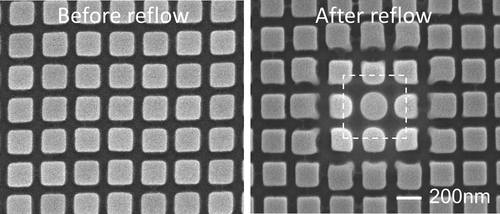Our official English website, www.x-mol.net, welcomes your
feedback! (Note: you will need to create a separate account there.)
Ion-Induced Localized Nanoscale Polymer Reflow for Three-Dimensional Self-Assembly
ACS Nano ( IF 15.8 ) Pub Date : 2018-09-12 00:00:00 , DOI: 10.1021/acsnano.8b05283 Chunhui Dai 1 , Kriti Agarwal 1 , Jeong-Hyun Cho 1
ACS Nano ( IF 15.8 ) Pub Date : 2018-09-12 00:00:00 , DOI: 10.1021/acsnano.8b05283 Chunhui Dai 1 , Kriti Agarwal 1 , Jeong-Hyun Cho 1
Affiliation

|
Thermal reflow of polymers is a well-established phenomenon that has been used in various microfabrication processes. However, present techniques have critical limitations in controlling the various attributes of polymer reflow, such as the position and extent of reflow, especially at the nanoscale. These challenges primarily result from the reflow heat source supplying heat energy to the entire substrate rather than a specific area. In this work, a focused ion beam (FIB) microscope is used to achieve controllable localized heat generation, leading to precise control over the nanoscale polymer reflow. Through the use of the patterning capability of FIB microscopy, dramatically different reflow performances within nanoscale distances of each other are demonstrated in both discrete periodic and continuous polymer structures. Further, we utilize a self-assembly process induced by nanoscale polymer reflow to realize 3D optical devices, specifically, vertically aligned nanoresonators and graphene-based nanocubes. HFSS and Comsol simulations have been carried out to analyze the advantages of the polymer-based 3D metamaterials as opposed to those fabricated with a metallic hinge. The simulation results clearly demonstrate that the polymer hinges have a dual advantage; first, the removal of any interference from the transmission spectrum leading to strong and distinct resonance peaks and, second, the elimination of parasitic leeching of the enhanced field by the metallic hinge resulting in stronger volumetric enhancement. Thus, the 2-fold advantages existing in 3D polymer-hinge optical metamaterials can open pathways for applications in 3D optoelectronic devices and sensors, vibrational molecular spectroscopy, and other nanoscale 3D plasmonic devices.
中文翻译:

三维自组装的离子诱导局部纳米级聚合物回流
聚合物的热回流是一种公认的现象,已在各种微细加工过程中使用。然而,本技术在控制聚合物回流的各种属性,例如回流的位置和程度,特别是在纳米级时,具有严格的限制。这些挑战主要是由于回流热源向整个基板而不是特定区域提供热能。在这项工作中,聚焦离子束(FIB)显微镜用于实现可控制的局部热量生成,从而导致对纳米级聚合物回流的精确控制。通过使用FIB显微镜的图案化功能,在离散的周期性和连续聚合物结构中,都证明了彼此之间纳米级距离内的显着不同的回流性能。进一步,我们利用纳米级聚合物回流诱导的自组装过程来实现3D光学设备,特别是垂直排列的纳米谐振器和基于石墨烯的纳米立方体。已经进行了HFSS和Comsol仿真,以分析基于聚合物的3D超材料与使用金属铰链制造的材料相比的优势。仿真结果清楚地表明,聚合物铰链具有双重优势。首先,消除了传输光谱中的任何干扰,从而导致了明显的共振峰,其次,第二,消除了金属铰链对增强磁场的寄生浸出,从而增强了体积。因此,3D聚合物铰链光学超材料的2倍优势可以为3D光电设备和传感器中的应用开辟道路,
更新日期:2018-09-12
中文翻译:

三维自组装的离子诱导局部纳米级聚合物回流
聚合物的热回流是一种公认的现象,已在各种微细加工过程中使用。然而,本技术在控制聚合物回流的各种属性,例如回流的位置和程度,特别是在纳米级时,具有严格的限制。这些挑战主要是由于回流热源向整个基板而不是特定区域提供热能。在这项工作中,聚焦离子束(FIB)显微镜用于实现可控制的局部热量生成,从而导致对纳米级聚合物回流的精确控制。通过使用FIB显微镜的图案化功能,在离散的周期性和连续聚合物结构中,都证明了彼此之间纳米级距离内的显着不同的回流性能。进一步,我们利用纳米级聚合物回流诱导的自组装过程来实现3D光学设备,特别是垂直排列的纳米谐振器和基于石墨烯的纳米立方体。已经进行了HFSS和Comsol仿真,以分析基于聚合物的3D超材料与使用金属铰链制造的材料相比的优势。仿真结果清楚地表明,聚合物铰链具有双重优势。首先,消除了传输光谱中的任何干扰,从而导致了明显的共振峰,其次,第二,消除了金属铰链对增强磁场的寄生浸出,从而增强了体积。因此,3D聚合物铰链光学超材料的2倍优势可以为3D光电设备和传感器中的应用开辟道路,











































 京公网安备 11010802027423号
京公网安备 11010802027423号